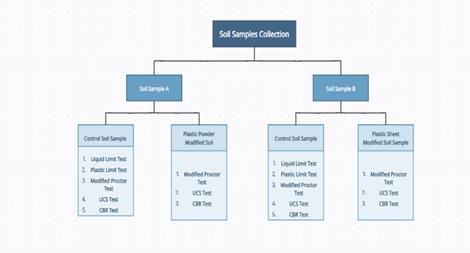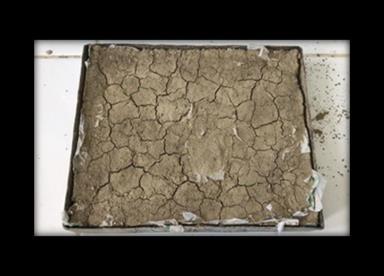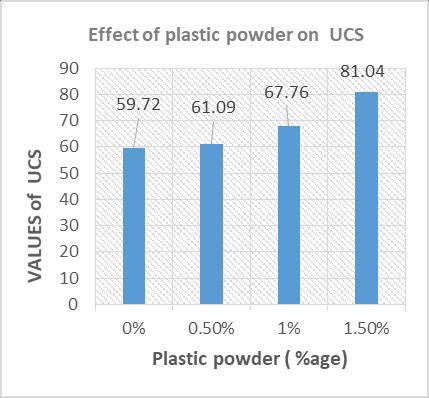
International Research Journal of Engineering and Technology (IRJET) e-ISSN:2395-0056
Volume: 12 Issue: 04 | Apr 2025 www.irjet.net p-ISSN:2395-0072
To investigative the geotechnical properties of soil by adding plastic waste as stabilizers (A solution to the clean & green environment)
Liaqat Ali1, Saleeh Nusri2, M. Zeeshan Ahad3 , Abdul Basit Khan4 , Noman Nigah 5, Jalal ud Din Khan6 , Qamar Zaman7
1PhD Scholar in Engineering and Build Environment Lincoln University College Malaysia
2Professor in Engineering and Build Environment Lincoln University College Malaysia
3Professor in Civil Engineering Department BRAINS Institute Peshawar,
4Lecturer in Civil Engineering Department BRAINS Institute Peshawar
5Deputy Director Technical University of Engineering & Technology Peshawar
6Deputy Director Technical Peshawar Development Authority Peshawar
7Assistant Director Works University of Agricultural Peshawar
ABSTRACT:
As a result of the increasing amount of plastic waste, such as bottles, polythene bags, and packing strips, which is also a hindrance in this research work an effort has been made to use these plastic wastes for improving ground and also solution to the environmental problems. Soil reinforcement is utilized in geotechnical engineering applications for a number of ground improvement schemes, including subgrades for footings and pavements, landfill liners and covers, failed slopes, and backfill for earth retaining structures.. The goal of the study is to determine how plastic waste affects the stability and improves the engineering properties of the chosen soil. The physical, chemical, and designing properties of the soil were considered, and the soil was treated with additional.
Key Words: Plastic powder. Plastic sheet, CBR, UCS and CBR
1. INTRODUCTION
Normal soil is an extremely complex and multifaceted substance. Given its complete accessibility and low effort requirements, it presents fantastic opportunities for effective utilization as a building or establishing material. The weathered material of the earth's exterior, with or without natural problems, is called soil for a geotechnical build. Soil is composed of distinct particles that are not unquestionably cemented together. The reason for their poor mechanical qualities is that they are free to move in relation to one another. In order to design geotechnical applicationsthatincluderefillingearthholdingstructures, repairing fizzled slopes and inclines, repairing landfill linersandspreads,and adjustingsoillayersandlevelsfor footingsandasphalts,soilsupportistriedforawiderange ofgroundchangeconspires.Thenormalgivenitscomplete accessibility and low effort requirements, it presents fantastic opportunities for effective utilization as a
building or establishing material. The weathered material oftheearth'sexterior,withorwithoutnaturalproblems,is called soil for a geotechnical build. Soil is composed of distinct particles that are not unquestionably cemented together.Thereasonfortheirpoormechanical qualities is that they are free to move in relation to one another. In order to design geotechnical applications that include refilling earth holding structures, repairing fizzled slopes and inclines, repairing landfill liners and spreads, and adjusting soil layers and levels for footings and asphalts, soil support is tried for a wide range of ground change conspires. Normal soil is an extremely complex and multifacetedsubstance.
Plastic waste causes major environmental problems. They obviously don't actually harm people's health, but they need a huge amount of space to reach at their destination and also consume a lot of energy for their generation. In the same way, waste plastic blocks seepage channels, which frequently results in water confinement and waste logging in cities and towns. Over the years, the Environmental Department has established accepted guidelines for managing plastic trash and has proposed further feasible waste reuse. From a variety of angles, plastic garbage and waste are being recycled as a costeffectiveassetmanagementtechnique.In2002,thePlastic trash Administration Foundation found that around 55% of plastic trash is being used effectively for sustainability stock reuse and vitality recovery. Each and every kind of plastic is they obviously don't actually harm people's health, but they need a huge amount of space to reach at theirdestinationandalsoconsumealotofenergyfortheir generation. In the same way, waste plastic blocks seepage channels, which frequently results in water confinement andwasteloggingincitiesandtowns.
Over the years, the Environmental Department has establishedacceptedguidelinesformanagingplastictrash and has proposed further feasible waste reuse. From a

International Research Journal of Engineering and Technology (IRJET) e-ISSN:2395-0056
Volume: 12 Issue: 04 | Apr 2025 www.irjet.net p-ISSN:2395-0072
variety of angles, plastic garbage and waste are being recycled as a cost-effective asset management technique. In 2002, the Plastic trash Administration Foundation found that around 55% of plastic trash is being used effectively for sustainability stock reuse and vitality recovery. Plastic waste causes major environmental problems. They obviously don't actually harm people's health, but they need a huge amount of space to reach at theirdestinationandalsoconsumealotofenergyfortheir generation. In the same way, waste plastic blocks seepage channels, which frequently results in water confinement and waste logging in cities and towns. Over the years, the Environmental Department has established accepted guidelines for managing plastic trash and has proposed further feasible waste reuse. From a variety of angles, plastic garbage and waste are being recycled as a costeffectiveassetmanagementtechnique.In2002,thePlastic trash Administration Foundation found that around 55% of plastic trash is being used effectively for sustainability stock reuse and vitality recovery. Plastic waste causes major environmental problems. They obviously don't actually harm people's health, but they need a huge amount of space to reach at their destination and also consumealotofenergyfortheirgeneration.
2. PROPLEM STATEMENT:
It seems hard to impose a restriction on the outline requirements in this rapidly evolving world. This undermines the fundamental reason the structure was built on such soil. Furthermore, when large quantities of the material are present, it is not cost-effective to remove it from the site. Perhaps it's challenging to find the most that being said, most developing nations find it difficult and costly to adopt those traditional methods. Plastic packs, however, are a prevalent and reasonably priced wasteitem.Reducingtheamountofwastethatendsupin landfillscouldbeachievedbyfindinganotheruseforthem in structural design projects. It seems hard to impose a restriction on the outline requirements in this rapidly evolvingworld.
3. RESEARCH OBJECTIVES:
The following are the main objectives of this research work
Enhancethesoilengineeringproperties.
Toprovidealternateremedyforplasticwaste disposal
Decreasing cost of soil stabilization by using cheapermaterial
4. RELATED WORK:
Subhash (2016) the author carried out an experiment on stabilizing soil using a proportionate blend of plastic and glass.TolookatOMCandCBR,severaltests,includingthe
ProctorTests,weremodified.Thestudy'sfindingsindicate that as the amount of glass and plastic increases, the Maximum Dry Density (MDD) level decreases. Glass and plastic make up around 6% of the total, and their maximum dry density was measured at 1.51 gram per centimeter.Whentheadmixturewasblendedat5.9%,the maximum OMC was observed at 22.4%. Furthermore, an increaseintheOMClevelwasobserved,reachingapeakof 22.5%. Based on 0.610 kg/cm2 to 3.022 kg/cm2, the unconfined compressive strength is more than 4.5 times thatofthesampleoftheauthorcarriedoutanexperiment on stabilizing soil using a proportionate blend of plastic andglass.TolookatOMCandCBR,severaltests,including the Proctor Tests, were modified. The study's findings indicate that as the amount of glass and plastic increases, the Maximum Dry Density (MDD) level decreases. Glass and plastic make up around 6% of the total, and their maximum dry density was measured at 1.51 gram per centimeter.Whentheadmixturewasblendedat5.9%,the maximumOMCwasobservedat22.4%.
In 2016, Mallikarjuna The author tried stabilizing soil in black cotton fields by using plastic waste. The author primarily accommodates the trials to address the challenges in Amaravathi, the capital of Andhra Pradesh, India. A soil sample made of black cotton is mixed with varying percentages of plastic strip weight, ranging from 0.0% to 8.5%.Soil and the optimal ratio of plastic waste stripswereanalyzedusingtheCBRTest.Samplesofplastic from discarded chairs are separated into many strips. Density of 0.40 gm/cc plastic strip combined with black cotton soil in varying amounts (1%, 3%, 5%, and 7%). In this study, the soil sample was subjected to a modified Proctortestanda numberofCBRtests.Theauthorclaims that the worth of the author tried stabilizing soil in black cotton fields by using plastic waste. The author primarily accommodates the trials to address the challenges in Amaravathi,thecapitalofAndhraPradesh,India.
N.M. Ilies (2017) there are two methods to improve the qualitiesofsoilinthisresearchreport.Using plasticwaste to improve soil mixing was the initial method. A further cement-improvement technique. The source of the plastic garbageusedinthisexperimentispolyethenewaste.Shear strengthmetricsareexaminedinthestudyastheychange with varying additions of cement or polyethene, such as 2%, 4%, 6%, and 8%. The silty clay used for the investigationwasused.When4%Polyethenewasaddedto the soil, different changes were seen. When compared to the same amount of cement soil combination, the 4% Polyethene soil mixture has a lower cohesiveness of around 51% and a lower internal friction angle of about 62%. In the end, polyethene was more effective even though the soil cement sample did better. There are two methods to improve the qualities of soil in this research report.Usingplasticwastetoimprovesoilmixing wasthe initialmethod.

International Research Journal of Engineering and Technology (IRJET) e-ISSN:2395-0056
Volume: 12 Issue: 04 | Apr 2025 www.irjet.net p-ISSN:2395-0072
Kiran (2017) Stabilization procedures aim to increase the soil's bearing capacity and stiffness. The soil must have both workability and build ability. Using strips of plastic bottles and shopping bags, the experiment's creator investigated ways to improve the many engineering propertiesofsoil.ThisstudyindicatesthatsoilCBRvalues rise,reachingtheirmaximumwhen0.74%ofplasticbottle strips are added to a soil sample. As the number of strips increases,theCBRvaluedecreases.Inthesecondexample utilizingdirt,itwasfoundthattheidealquantityofplastic bag strips is around 2% of the total weight of the soil. Plasticbottlestrips,theauthorconcluded,increasethesoil sample’sStabilizationproceduresaimtoincreasethesoil's bearing capacity and stiffness. The soil must have both workabilityandbuildability.
Table-1: CBR Values with plastic strip
This experimental research work (N. Vijay Kumar, 2017) dealswiththeobservationofplasticgarbageusedasasoil stabilizer, primarily in black cotton soil. This soil's shortcomings included uneven surface settlement, shrinkage, and swelling when hit by precipitation. A variety of engineering experimental tests, such as the plastic limit, liquid, and standard proctor tests, are conducted for soil stabilization in this research paper. Additionally, tests for unconfined compressive strength andtheCaliforniabearingratioareconductedtoverifythe changes made to the technical properties of the soil. In order to boost the soil sample's bearing capacity, the researchpieceusesplasticandbottlestrips.TheCBRvalue isshownasafunctionofplasticstriplengthinTable3.The CBR. This soil's shortcomings included uneven surface settlement, shrinkage, and swelling when hit by precipitation. A variety of engineering experimental tests, suchastheplasticlimit,liquid,andstandardproctortests, are conducted for soil stabilization in this research paper. Additionally, tests for unconfined compressive strength andtheCaliforniabearingratioareconductedtoverifythe changes made to the technical properties of the soil. In order to boost the soil sample's bearing capacity, the researchpieceusesplasticandbottlestrips.TheCBRvalue isshownasafunctionofplasticstriplengthinTable3.
(Peddaiah, 2018) He uses a number of studies, including thedirectsheartest,theCalifornia BearingRatiotest,and the compaction test, to investigate how plastic bottles affect silty sand. Plastic waste strips measuring 15.0 mm
by 15.0 mm, 15.0 mm by 25.0 mm, and 15.0 mm by 35.0 mm were combined with plastic components in the percentages of 0.20%, 0.40%, 0.60%, and 0.80%. As the amount of plastic material increases, properties such as the maximum dry unit weight and shear strength characteristicsalsorise.TheCBRvaluesofthesoilsample for0.20%and3.2percentplastic,respectively,rangefrom 3.2 to 7.2, according this study. For a plastic content of 0.40% to 16.4. When the amount of naturally silty plastic in this study he uses a number of studies, including the directshear test,theCalifornia Bearing Ratiotest,and the compaction test, to investigate how plastic bottles affect siltysand.Plasticwastestripsmeasuring15.0mmby15.0 mm,15.0mmby25.0mm,and15.0mmby35.0mmwere combined with plastic components in the percentages of 0.20%,0.40%,0.60%,and0.80%.Astheamountofplastic material increases, properties such as the maximum dry unit weight and shear strength characteristics also rise. The CBR values of the soil sample for 0.20% and 3.2 percent plastic, respectively, range from 3.2 to 7.2, accordingthisstudyforaplasticcontentof0.40%to16.4.
(TarunKumar(2018)Headdedthatusingplasticstripsof varying diameters is an alternate technique for stabilizing soil. Numerous studies are performed to examine stabilizationcausedbytheimpactsofvariousmixedstrips ofplastic,includingmodifiedproctorexamsandunsoaked California bearing ratio tests. The result shows that when the quantity of plastic waste strips increases, the MDD of the plastic mixed soil sample decreases. CBR rises in tandemwiththeproportionofplasticwastestripsthatfall within an ideal range. According to research, MDD levels decreaseasOptimalMoistureContentvaluesincrease.The degree of CBR values of the plastic strip composed of residual plastic components has been found to rise. He added that using plastic strips of varying diameters is an alternate technique for stabilizing soil. Numerous studies are performed to examine stabilization caused by the impacts of various mixed strips of plastic, including modified proctor exams and unsoaked California bearing ratiotests.
The experiment by (Abdelsalam, 2019) involved adding a tiny quantity of High-Density Polyethylene (HDPE) to cohesive soil. The direct shear test and the onedimensional consolidation test were among the several experiments the author experimented with. to ascertain the shear strength and consolidation engineering properties of the soil sample. 5.0%, 10.0%, 15.0%, and 0.0%HDPEcontentadditions.Theyrangefrom25KPaand 36° to 44 KPa and 45°, respectively, for cohesiveness and internal friction angle. HDPE content ranged from 15% to 0%. The soil sample's coefficient of permeability and compressibility are improved by a small addition of 5.0% HDPE.

International Research Journal of Engineering and Technology (IRJET) e-ISSN:2395-0056
Volume: 12 Issue: 04 | Apr 2025 www.irjet.net p-ISSN:2395-0072
5. RESEARCH METHDOLOGY:
In this research workTwo soil samples, designated soil samples A and B, were gatheredand broughtintothelab. Thequalitiesofclayeysoilwereinvestigatedusinglocally availablematerialplasticwasteintheformofpowderand plastic sheet in order to achieve the examination's goals. Byweightofdrysoil,theamountofaddedmaterialis0%, 0.5%, 1%, and 1.5% in the form of powder and plastic sheets of dimension 5mm*7.5mm, 10mm*15mm and 15mm*20mm. The mixing percentage by weight were 0.5%,1% and 2%. The results obtained using the ASTM principles were examined in order to investigate the geotechnical qualities and develop conclusions. Selecting the best additional material and suitable offer to use would be difficult due to the wide range of soil types and conditionsaswellasthevarioustypesofaddedchemicals. Thequalitiesofclayeysoilwereinvestigatedusinglocally available materials plastic bags in order to achieve the examination'sgoals

5
This section will outline the specific tactics used in each test conducted at the research institution to achieve the examination's goals. All of the examples used in this examination were created in the laboratory using readily available standard techniques, and the clay was collected from the agricultural side of Peshawar from a 3x3-foot trial pit depicted in figure 3.1. Specimens are to be collected from 4 trial pits. Admixture was regarded as a promising stabilizer to treat or improve the qualities of soilforthetestingprogramattheresearchfacility.





International Research Journal of Engineering and Technology (IRJET) e-ISSN:2395-0056
Volume: 12 Issue: 04 | Apr 2025 www.irjet.net p-ISSN:2395-0072

Fig-6: Plastic sheet with soil
The study is separated into four groups according to the mix admixture added as a percentage of the dry soil's weight. The dirt was set to air dry overnight in a big container before being divided to fit through the 3/8" sieve.Togetridofthelargerparticles,ASTMD2216wetly sievedthesoiltestovera#40sieve.Sincethe#40strainer utilizes less material than the #10 sieve, it was used instead. The substance was separated and then subjected toseveral testing, including atterberg,s limitsandstrainer analysis.
Table-2: Properties of Control soil sample Soil
4. EXPERIMENTAL TESTS AND RESULTS
Results obtained from the experiments performing in laboratory have been discussed in this section. Different experiments were conducted on soil by adding plastic powderasstabilizerin0.5%,1%and1.5%atcontrollevel theMDD,UCS&CBRvalueswererecordedaso.127,59.72 &3.62respectivelywhentheglasspowderwasaddedthe these values were observed to increase from its original valuesasshownintable-
Table -4: Mix Proportions for soil sample-A
Table -3: Test Name & Codes
TEST ASTM CODE
MDD D422
UCS D4318
CBR 42216
Effect of plastic powder on Dry Density
Plastic powder ( %age)
Fig-7: Effect of P.P on Dry Density
FromtheabovefigurecanbeobservedthattheMaximum dry density value increase with the increase of glass powdercontentat0%thevaluewasrecordedas0.127,at 0.5% the value was recorded 1.73 at 1% was 1.74 and at 1.5% was 1.76. it mean that the maximum dry density of soilincreasewithstabilizerglasspowder.

International Research Journal of Engineering and Technology (IRJET) e-ISSN:2395-0056
Volume: 12 Issue: 04 | Apr 2025 www.irjet.net p-ISSN:2395-0072
Table -5: Mix Proportions for soil sample -B
Fig-8: Fig-7: Effect of P.P on CBR
Similarlythe valueof CBR forpure soilis3.62when glass powder was added to it its value increases at 0.5% it was recorded5.08at1%itwasrecorded6.27and1.5%itwas observed7.87. Itmean that withaddition ofglasspowder thestrengthofsubgradeincreases.

Same for UCS its value in pure soil is 59.72 when glass powder was added to it its value increases at 0.5% it was recorded 61.09 at 1% it was recorded 67.76 and 1.5% it was observed 81.04. It mean that with addition of glass powderthestrengthofsoilincreases.
From the above result discussion it is concluded that the plastic in the form of powder is best stabilizer for improvingthegeotechnicalpropertiesofsoil.
Now for soil sample –B the plastic sheets were added to the soil sample in different percentages 0.50%, 1% and 2%.Thementionedpercentageofplasticsheetswerekept constantonlythedimensionofplasticsheetwerechanged which are 5mm*7.5mm, 10mm*15mm & 15mm*20mm as showninthetablebelow
Effect of P.sheet on Dry Density
Form the Figure it can be observed that when the size of theplasticsheetistheMDD valuedecreasewithin size of theplasticsheetis5mm*7.5mmat0%itsvaluewas12.82 whenthepercentagewas0.50%itsvaluereducedto11.97 at 1% its value was 12.56 which is again less than 12.82 whileat2%itsvaluewasrecorded12.8.

International Research Journal of Engineering and Technology (IRJET) e-ISSN:2395-0056
Volume: 12 Issue: 04 | Apr 2025 www.irjet.net p-ISSN:2395-0072
Effect of Plastic Sheet (5mm*7.5mm) On UCS
Fig-11: Effect of P.sheet on UCS
Effect of Plastic Sheet ( 5mm*7.5mm) On CBR
Fig-12: Effect of P.sheet on CBR
Fig-13: Effect of P.sheet on CBR
Sheet in %age Effect of Plastic Sheet( 15mm*20mm) On Dry Density
Fig-14: Effect of P.sheet on Dry Density
Effect of Plastic Sheet ( 10mm*15mm) On UCS
%age
Fig-15: Effect of P.sheet on UCS
Effect of Plastic Sheet ( 15mm*20mm) On CBR
Fig-16: Effect of P.sheet on CBR

International Research Journal of Engineering and Technology (IRJET) e-ISSN:2395-0056
Volume: 12 Issue: 04 | Apr 2025 www.irjet.net p-ISSN:2395-0072
Fig-17: Effect of P.sheet on UCS
Fig-18: Effect of P.sheet on UCS

Fig-19: Effect of P.sheet on UCS
Form the above Figures it can be observed that the CBR valueis1.58forpuresoil sample-Bwhentheplasticsheet of size 5mm* 7.5mm is added it value increases to 1.71 at 0.50%and1%valuewas itsvalueincreasesto1.71at1% itsvaluewas2.01and2% itsvaluewasrecorded1.96.it can be observed that when the size of the plastic sheet is theMDDvaluedecreasewithinsizeofthe plasticsheet is 5mm* 7.5mm at 0% its value was 12.82 when the Percentagewas0.50%itsvaluereducedto11.97at1%its valuewas12.56whichisagainlessthan12.82whileat2% its value was recorded 12.8. It can be observed that the UCS value is 59.72 for pure soil when the plastic sheet of size 5mm* 7.5mm is added it value increases at 0.50% its valueincreasesto257.2at1%itsvaluewas273.7itsvalue was recorded 304.4. From this result discussion it is concluded that the plastic in the form of powder is best stabilizerforimprovingthegeotechnicalpropertiesofsoil. itcanbeobservedthatwhenthesizeoftheplasticsheetis theMDDvaluedecreasewithinsizeofthe plasticsheet is 5mm* 7.5mm at 0% its value was 12.82 when the percentagewas0.50%itsvaluereducedto11.97at1%its valuewas12.56whichisagainlessthan12.82whileat2% its value was recorded 12.8. From the above result discussion it is concluded that the plastic in the form of sheetisbeststabilizerforimprovingtheCBRvalueofsoil.
CONCLUSION
By using appropriate ground improvement materials and processes, the quality of the ground must be improved for constructionsafety.Thesoilthatneedstobeimproved,the resources that are available, and the cost-effectiveness all influencethegroundrestorationapproachthatisused.
In order to stabilize soil and enhance its engineering qualities,plasticwastecanbeusedintheformpowderand sheets ofdifferentsizes..Theseadmixtures areregarded as one ofthe most widely used and reasonably priced ground improvement methods for stabilizing weak soil deposits. It isanticipatedthatadding plasticpowderandplasticsheets to less suitable soil may increase its porosity, decrease its durability, and weaken its cohesiveness, among other effects. The soil that needs to be improved, the resources thatareavailable,andthecost-effectivenessallinfluencethe groundrestorationapproachthatisused.
Thefollowingconclusionsarederivedfromthisstudybased ontheobservationsandconclusions
1. According to the Maximum dry density of soil can be enhanced both through plastic powder and plastic sheet.
2. Designing and building subgrade, embankment, and structuralfillsfortheuseof plasticpowderandplastic sheet, as stabilizing agents will benefit from the data derivedfromtheconductedinvestigations.

International Research Journal of Engineering and Technology (IRJET) e-ISSN:2395-0056
Volume: 12 Issue: 04 | Apr 2025 www.irjet.net p-ISSN:2395-0072
3. Reusing waste materials such as plastic powder and plastic sheets has financial benefits and poses no environmental risks, which is a key finding of this study..
4. Based on numerous investigations, it has been determined that plastic materials like plastic powder andplasticsheetsareinertandbeneficialinalltypesof weather. They are the most advantageous option for stabilizing soil because they are economical and nonbiodegradable.Theinclusionofseveraltypesofplastic. It has been observed that the soil is suitable for construction due to its engineering properties. As the strip length grows, so do the California Bearing Ratio (CBR)andshearstrengthratings.Finally,forarangeof soil stabilizing applications, including pavement subgrade,anumberofplasticmaterialscanbeused.
5. Based on the aforementioned findings, it may be concluded that plastic wastes in the form powder and sheets can be utilized as stabilizing admixtures in less desirableclayeysoil.
6. RECOMENDATIONS
According to a number of studies, plastics like plastic powder and plastic sheets are beneficial in all types of weather because of their inertness. They are the most advantageous option for stabilizing soil because they are economical and non-biodegradable. The incorporation of different plastic materials. It has been observed that the soil is suitable for construction due to its engineering properties. Maximum dry density and the California Bearing Ratio (CBR) it must be established whether stabilized plastic waste can withstand the durability constraintsoffreeze,thaw,shrinkage,moisture,etc.before beingusedasabasematerial.
REFERENCES
[1]Consoli, N.C., da Silva Lopes Jr, L. and Heineck, K.S., 2009.Keyparametersforthestrengthcontrol oflime stabilized soils. Journal of materials in Civil Engineering,21(5),pp.210-216.
[2]Correia, A.A., Oliveira, P.J.V. and Custódio, D.G., 2015. Effectofpolypropylenefibresonthecompressiveand tensilestrengthofasoftsoil,artificiallystabilisedwith binders.GeotextilesandGeomembranes,43(2),pp.97106.
[3]Chebet, F.C and Kalumba, D., 2014. Laboratory Investigation on Re-Using Polyethylene (Plastic) Bag Waste Material for soil reinforcement in Geotechnical Engineering.CivilEngineeringandUrbanPlanning:An InternationalJournal(CIVEJ),1.
[4]Diambra, A., Ibraim, E., Wood, D.M. and Russell, A.R., 2010. Fibre reinforced sands: experiments and modelling. Geotextiles and geomembranes, 28(3), pp.238-250.
[5]Hataf, N. and Rahimi, M.M., 2006 Experimental investigation of bearing capacity of sand reinforced with randomly distributed tire shreds. Construction andBuildingMaterials,20(10),pp.910-916.
[6]Hejazi, S.M., Sheikhzadeh, M., Abtahi, S.M. and Zadhoush, A., 2012. A simple review of soil reinforcement by using natural and synthetic fibers. Constructionandbuildingmaterials,30,pp.100-116
[7]Ibraim, E., Diambra, A., Russell, A.R. and Wood, D.M., 2012. Assessment of laboratory sample preparation for fibre rein Consoli, N.C., Vendruscolo, M.A., Fonini, A.andDallaRosa,F.,2009.Fiberreinforcementeffects on sand considering a wide cementation range. Geotextiles and Geomembranes, 27(3), pp.196203.forced sands. Geotextiles and Geomembranes, 34, pp.69-79.
[8]Kalumba, D., 2013. Using shredded plastic shopping bagswastesinsoilimprovement.
[9]Miller, C.J. and Rifai, S., 2004. Fiber reinforcement for waste containment soil liners. Journal of EnvironmentalEngineering,130(8),pp.891-895.
[10] Mender, F.N.. 2015. Stabilization of Clayey Soil Using Polyethylene and Polypropylene (Doctoral dissertation,UMP).
[11] Makusa,G.P.,2013.Soil stabilizationmethodsand materials in engineering practice: State of the art review.
[12] Mandal, J.N. and Labhane, L., 1992. A procedure forthedesignandanalysisofgeosyntheticreinforced soil slopes. Geotechnical engineering, 10(4), pp.291319.
[13] Maher, M.H. and Gray, D.H., 1990. Static response of sands reinforced with randomly and geological distributed fibers. Journal of Geotechnical Engineering, 116(11), pp.1661-1677. Morel, J.C. and Goure,J.P.,1997.
[14] Mechanicalbehaviorofsandreinforcedwithmesh elements. Geosynthetics International, 4(5), pp.481508,
[15] Nacini,S.A.andSadjadi,S.M.,2008.Effectofwaste polymer materials on shear strength of unsaturated clays.ElectronJGeotechEng,13,pp.1-12.

International Research Journal of Engineering and Technology (IRJET) e-ISSN:2395-0056
Volume: 12 Issue: 04 | Apr 2025 www.irjet.net p-ISSN:2395-0072
[16] Perern, A.S.R., Al-Tabbaa, A., Reid, J.M. and Johnson, D., 2005, April. State of practice report UK stabilization/solidification treatment and remediation, Part V: long- term performance and environmental impact. In Proceedings of the International Conference on Stabilization/Solidification Treatment and Remediation.Cambridge(pp.437-457),
Author Profile:

Engr.LiaqatAli
PhDScholar
inCivilEngineering LincolnUniversityCollegeMalaysia
